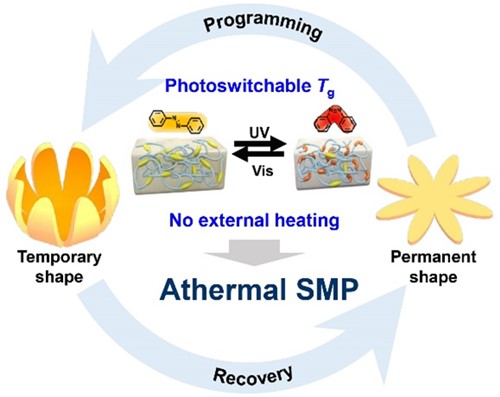Search
Title: Rapid, Localized, and Athermal Shape Memory Performance Triggered by Photoswitchable Glass Transition Temperature
Author: Xiao Zhang, Chongyu Zhu, Bo Xu, Lang Qin, Jia Wei, Yanlei Yu*
Journal: ACS Appl. Mater. Interfaces, 2019, 11(49), 46212-46218
Abstract:
Shape memory polymers that undergo shape recovery at room temperature (RT) are desirable for their potential in vivo applications, yet challenging. Herein, light-triggered athermal shape memory effect of azopolymer networks is reported by photoswitching the glass transition temperature (Tg) rather than external heating. Thanks to the switchable Tg of azopolymer induced by reversible trans−cis isomerization, the entropic energy is trapped in low Tg state (cis-form Tg < RT) to deform into a temporary shape and fixed in high Tg state (trans-form Tg > RT). Upon exposure to UV light, the reduced low Tg allows release of the entropic energy, realizing athermal shape recovery of the permanent shape. By exploring the shape memory performance, we demonstrate diverse light-induced rapid shape recovery from temporary shape to original shape. Because of the instant, precise, and spatiotemporal manipulation of light, programmable shape recovery of surface topography is further extended. We anticipate that this strategy will provide tremendous opportunities for future precise medicine devices and soft robotics.
Fulltext Link: https://pubs.acs.org/doi/abs/10.1021/acsami.9b17271

Herein, we report a strategy to trigger athermal shape memory effect in an azobenzene-containing polymer network (APN) by photoswitching the Tg. Thanks to the switchable Tg of APN induced by reversible trans–cis isomerization of azobenzene groups, the entropic energy is stored and released via the switching between rubbery state and glassy state upon illumination. The cross-linked APN is readily reshaped into thin films and diverse 3D structures (cosmos and artificial mimosa) on heating by rearrangement of network topology due to transesterification of dynamic ester bonds. Because of the instant, precise manipulation of light, programmable shape recovery of surface topography is further extended, which will provide tremendous opportunities for future precise medicine devices and soft robotics.







